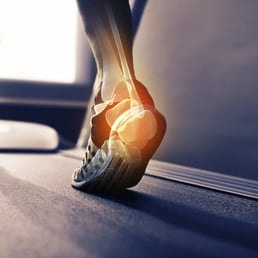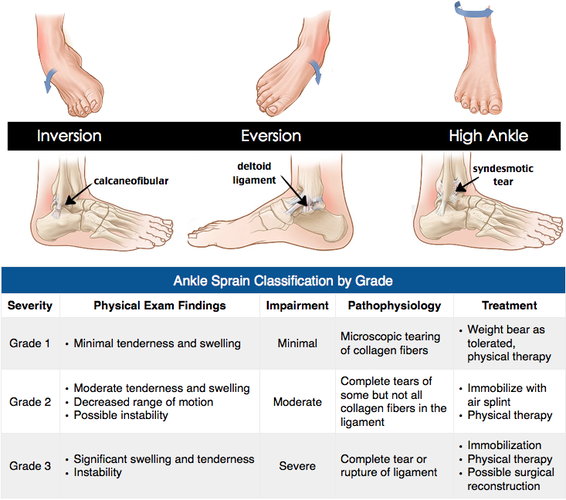|
An ankle sprain occurs when the ligaments of the ankle are undergone a force that stretches them beyond their capabilities and tear. Ligaments of the ankle are tough bands of tissue that provide support to hold the ankle bones together and prevent excessive movement. The lateral (outer) part of the ankle is made up of three ligaments the anterior talofibular ligament (ATFL), calcaneofibular ligament (CFL) and posterior talofibular ligament (PTFL). The deltoid ligament supports the entire medial (inner) aspect of the ankle. There is an interosseous ligament, which is tissues that runs between the entire length of the tibia and fibula. Most ankle sprains occur on the lateral aspect of the ankle, affecting the ATFL ligament. Anyone can experience an ankle sprain at any age. There are three different types of ankle sprains:
There are 3 grades to a sprain:
Phase 1 - Acute management of ankle sprain (within 24-72 hours of injury):
Phase 2 - Post-acute phase management (Recovery time will vary depending on severity):
Phase 3 – Return to play when all of the above is achieve:
Josh Hallinan Chiropractor Available for Appointment Tuesday & Thursday at Health Associates Vuurberg G, Hoorntje A, Wink LM, et al Diagnosis, treatment and prevention of ankle sprains: update of an evidence-based clinical guideline British Journal of Sports Medicine 2018;52:956. Kerkhoffs GM, van den Bekerom M, Elders LAM, et al Diagnosis, treatment and prevention of ankle sprains: an evidence-based clinical guideline British Journal of Sports Medicine 2012;46:854-860. Walls RJ, Ross KA, Fraser EJ, et al. Football injuries of the ankle: A review of injury mechanisms, diagnosis and management. World J Orthop. 2016;7(1):8–19. Published 2016 Jan 18. doi:10.5312/wjo.v7.i1.8 Wolfe, Michael W. "Management of ankle sprains." American family physician 63.1 (2001).
2 Comments
7/19/2023 12:32:03 pm
Awesome! Thank you for providing this important information. I heartily recommend visiting this website in order to learn more about a foot solution.
Reply
Leave a Reply. |
Archives
June 2021
|
|
Contact Details
Call 9542 3330
99A Loftus Ave, Loftus NSW 2232 Hours Monday & Wednesday 8am - 6pm Saturday: 8am - 12pm Early morning or later evening available by appointment Our reception is available for walk-ins on Monday, Wednesday & Saturday. Or by telephone 7 days. |




 RSS Feed
RSS Feed